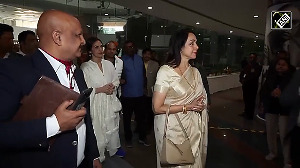Here's Scenario A: Mamata Banerjee tires of protesting - the first conciliatory move has apparently been made - outside the gates of the Tata Motors plant in Singur, West Bengal. The farmers who sold their land or did not sell their land for the Tata small car plant and its ancillary units get restless and want to move on in life.
All parties go into a huddle and come out with a solution which involves some giving up of land, some taking, better compensation for the farmers and maybe stakes, and the West Bengal government emerging, in all probability, as the lookout who did not spot the tip of the iceberg in the distance as the Titanic moved through the silent night.
And Scenario B: Mamata digs her heels further in, the Tatas' pull out of Singur as threatened and begin work in earnest in Uttarakhand, Karnataka or good ol Pune, where the Maharashtra chief minister has promised a "red carpet" welcome. As have several other states, including Orissa. Never mind that the latter has the worst track record when it comes to acting on investment announcements.
Would it be fair to assume then, that were Scenario A to play out, it would be some sort of resounding victory for the forces of industrialisation and development? Well, that's my fear. Because the answer is an equally resounding no. The answers are many but the danger lies in the implicit assumption that this is another delay and things will get sorted out. Am afraid not.
For starters, let's look at some of the businessmen who have issued statements in favour of Ratan Tata. The list begins with Mukesh Ambani, whose many plans for the state, including in retail, have met with stiff resistance. Reliance Retail's Fresh brand of five food stores opened in Kolkata, coincidentally, only a few days before the Singur controversy erupted in August. Earlier attempts to set up shop were thwarted.
It goes onto Sajjan Jindal of Jindal Steel, who himself is trying to set up several large projects. Jindal Steel announced a steel plant in 2004, and plans were renewed in 2006 with a power project as well. Today, the project has ballooned from 4 million tonnes to 10 million tonnes and calls for investments worth Rs 35,000 crore (Rs 350 billion). Except for land acquisition, the project is yet to hit the second gear. Or Ficci President Rajeev Chandrashekhar, whose own attempts (as part of the BPL Group) to set up power projects in the past (not in West Bengal) have hit crippling road blocks.
The list could go on, but this is not about saying that industrialist X or Y is using the Tata-Singur imbroglio to further his cause or let off some obvious frustration. Which they obviously are. As an aside, perhaps it was Ratan Tata's plain talking that reached out - "I am not going to risk the welfare of my staff and their families. And if we are not wanted in any way, we will leave the state."
But this is about what happens if only 5 or 10 per cent of all planned industrial projects in the country actually move from the land acquisition phase to concrete piling and sheds to actual production and dispatch. Or what's Plan B if they don't get off the ground in a reasonable time frame? As Mr Tata himself knows, Tata Steel has all its India expansion plans (three steel plants) on hold for many years now. To that extent, this is valuable time lost and cannot be regained.
And more importantly, who's thinking of Plan B in the context of the larger economic goals for the nation? I know the disaggregated answer at the state level but it's not clear to me how we are going to resolve what I would think is a matter (industrial investment) reaching crisis proportions.
Why, because it's going to affect three things: First, regional development; second jobs; and finally, prospective growth numbers. Recognise that Reliance Industries' new oil refinery at Jamnagar is expected to add half a per cent to GDP growth when it goes on stream soon. What if it had not taken off? Ditto with the several hundred thousand crores of projects waiting to start. And a much smaller one, being the Nano project in West Bengal. Finally, a headline-grabbing agitation like Singur does instill fear into investors, both domestic and overseas.
Is there a solution? Perhaps. Jindal said in Kolkata that compensation to farmers should be doubled and they should be made shareholders. "I am a farmer's son. I can understand," he said. That's clearly one approach.
But can this approach become a national blueprint for currently stuck and prospective industrial projects. That needs to be thrashed out. The second, to my mind, is for the big politicians to visit large sites and engage with the people, maybe at one shot, before the project takes off.
Turning up at foundation stone laying time is surely not working. There could and will be other ways - I argued last fortnight that there is something about the post-liberalisation approach to industrialisation that is not working. Singur was yet to explode then. But other approaches must be found. There is much more at stake here. For both the people of the land and the country at large.
I am tempted to end with a Jawaharlal Nehru quote following the inauguration of the Bokaro power plant and dam in 1953: "Whenever I see these great engineering works," he wrote, "I feel excited and exhilarated. They are visible symbols of building up the new India and of providing life and sustenance to our people." I am one of those who feel the same. Not everyone does, though. That's the most fundamental problem.






